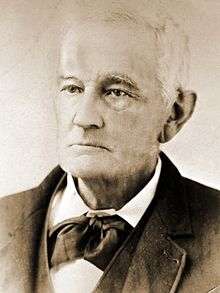Ben Barton
| Ben Barton | |
|---|---|
 | |
| Born |
June 8, 1823 South Carolina |
| Died | January 1, 1899 (aged 75) |
| Residence |
|
| Occupation | Doctor, landowner, vintner, politician, settler |
Ben Barton (June 8, 1823 – January 1, 1899), often erroneously referred to as Benjamin Barton,[1] was an American doctor, landowner, vintner, politician, and early white settler of the area that is now Redlands in the San Bernardino Valley of southern California in the United States.
Barton was born in South Carolina in 1823 to a family descended from European colonists of the area.[1] He studied medicine in Lexington, Kentucky, which he moved to in 1845. He lived and worked as a doctor in Texas and Alabama after his time in Kentucky.[1][2] He met and married his wife, Eliza Brite, in Texas, and they resided in El Paso until 1854.[1][3] In that year, he moved west with his wife to El Monte, California.[1][2][3] The Bartons had two sons during this time, John H. Barton (b. 1855) and Hiram Barton (b. 1856).[1]
In the late 1850s,[1][2][4] Barton was able to purchase large amounts of land from Mormons in Rancho San Bernardino at low prices due to Brigham Young's recalling the Mormon outpost in San Bernardino.[1][5] From Charles C. Rich and Amasa Lyman, leaders of the Mormon settlement in the area, he purchased, for $5,000 (approximately $137,000 today), 640 acres (2.6 km2) of property around the San Bernardino Asistencia, land known as Old San Bernardino as a late 17th century/early 18th century outpost of Mission San Gabriel Arcángel.[1][2][3][5] His purchases also included a number of properties within San Bernardino proper.[3] Barton was appointed the city's postmaster, and built a building in 1858 in San Bernardino out of adobe to house a post office, doctor's office, and pharmacy.[1][2][3] Due to Barton's other commitments, the post office was effectively overseen by John P. Barton, his brother. Also in 1858, Barton was elected school superintendent for the recently formed county of San Bernardino.[1]
In 1859, Barton and his family moved to the Asistencia and sold their San Bernardino home. Around this time, Barton shifted his focus from medicine to ranching and farming.[1][2][3][4] Some sources report that he gave up medicine entirely,[1][2] while others state he maintained a home office for some time.[3][4] Barton had the Barton Villa (now the oldest extant house in the city of Redlands)[5] built as a home for him and his family. He served as a member of the California State Assembly in the early 1860s, representing what was then the first district.[1][2][6][7] He died in 1899.[1]
Barton Road, which runs between Redlands and Grand Terrace, is named after him.[2] Barton and his sons' real estate holdings would come to be known as the Barton Ranch or Barton Tract, and after being subdivided and sold off into individual house lots, would eventually become the land incorporated as the city of Redlands.[1][2][3]
See also
References
- 1 2 3 4 5 6 7 8 9 10 11 12 13 14 15 16 Landis, Mark (2009-02-03). "Bartons were active in early development of SB Valley". The San Bernardino Sun. Retrieved 2016-08-23.
- 1 2 3 4 5 6 7 8 9 10 "Barton Road". City of San Bernardino. Retrieved 2016-08-23.
- 1 2 3 4 5 6 7 8 McCall, Joan Hedges (2012). Redlands Remembered: Stories from the Jewel of the Inland Empire. Charleston, South Carolina: The History Press. ISBN 9781609496180.
- 1 2 3 "The 'Asistencia'". San Bernardino County Museum. Retrieved 2016-08-23.
- 1 2 3 Hernandez, Kristina (2013-04-22). "Heritage Park in Redlands 25 years in the making". The Redlands Daily Facts. Retrieved 2016-08-23.
- ↑ JoinCalifornia.com-Benjamin Barton
- ↑ Kestenbaum, Lawrence. "Index to Politicians: Barton". The Political Graveyard. Retrieved 2016-08-23.